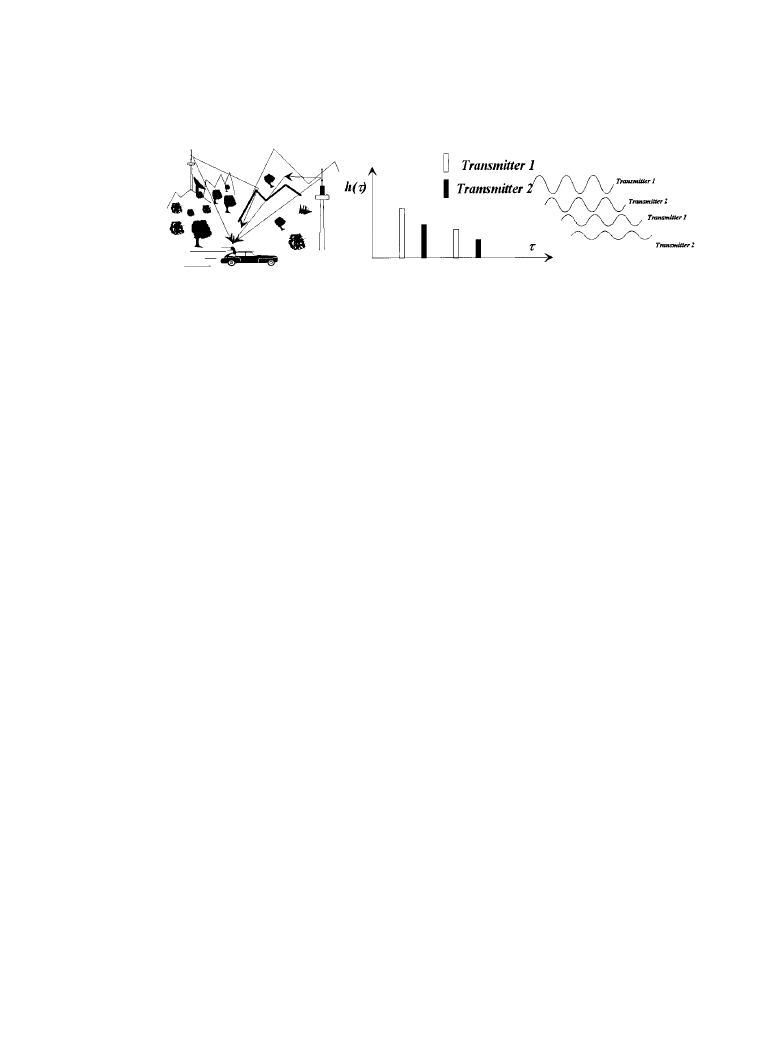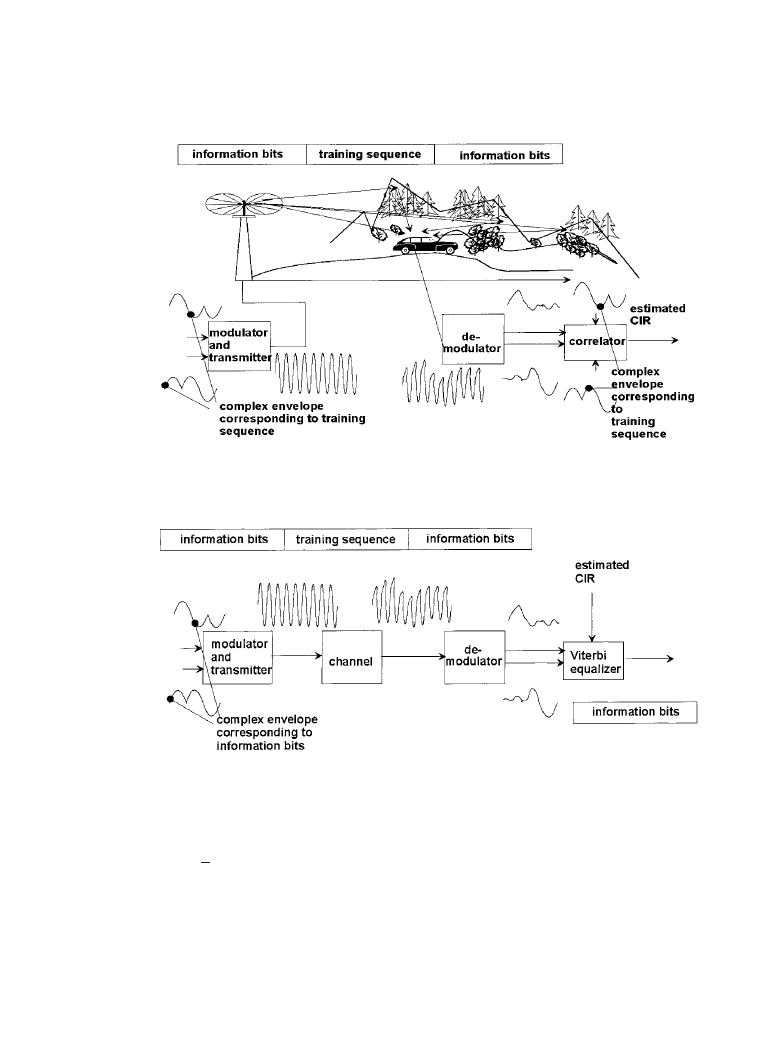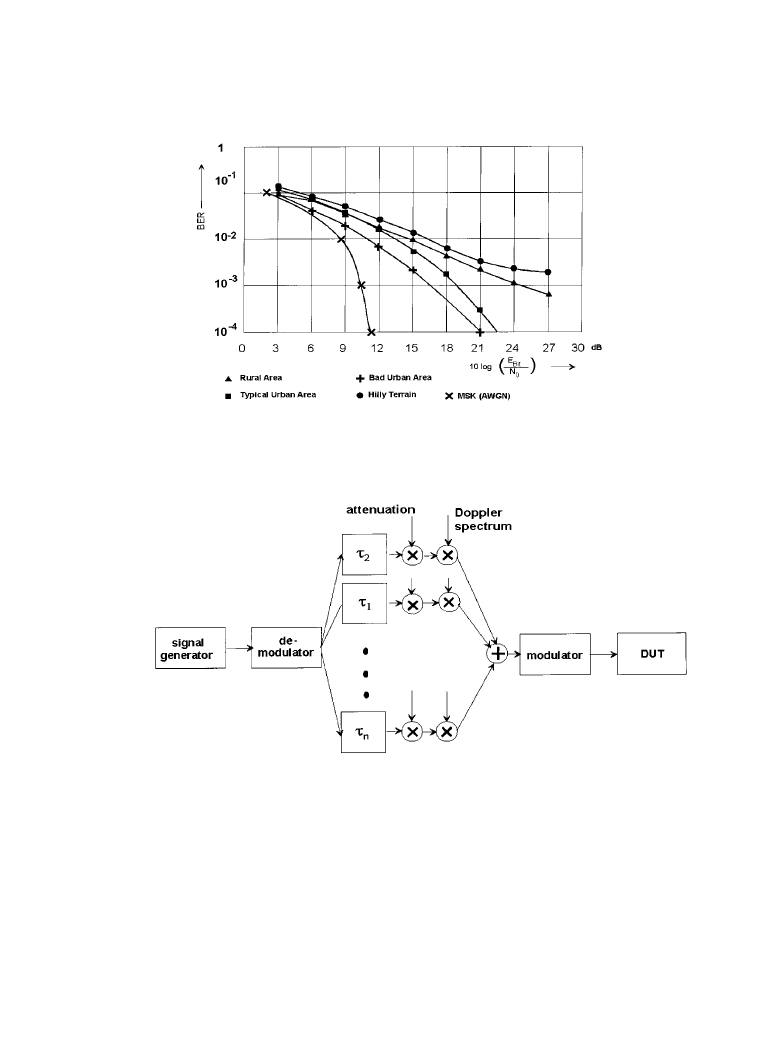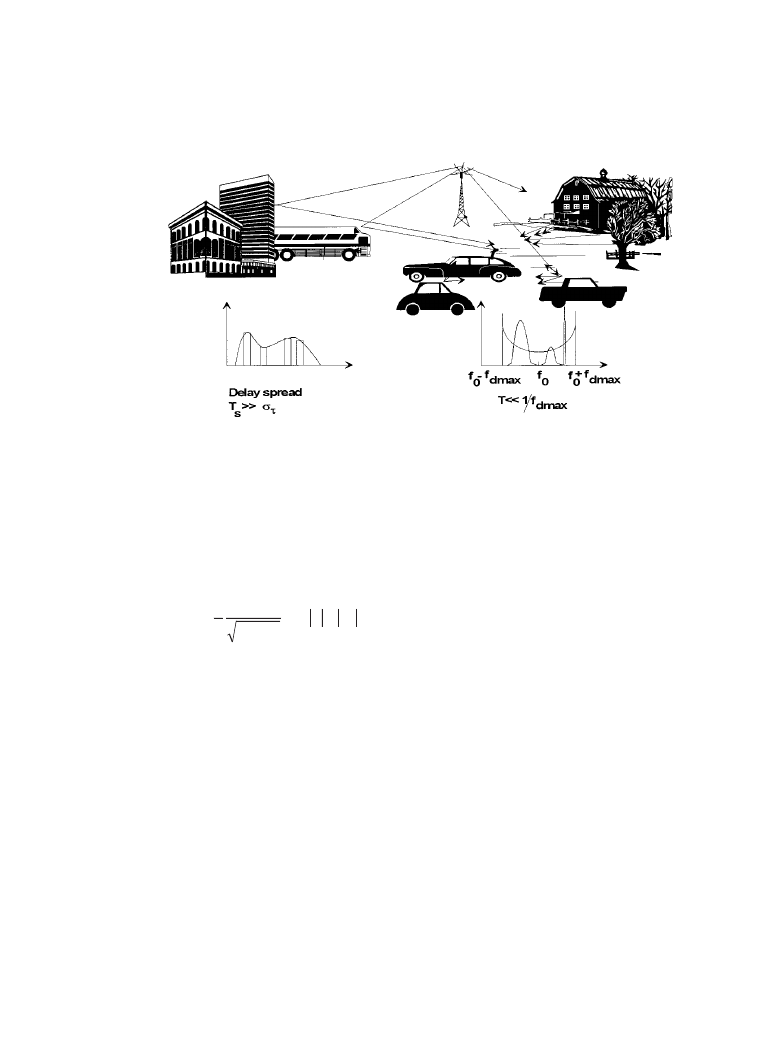ВУЗ: Казахская Национальная Академия Искусств им. Т. Жургенова
Категория: Книга
Дисциплина: Не указана
Добавлен: 03.02.2019
Просмотров: 21618
Скачиваний: 19

The Radio Channel 12-33
•
Rural area (RA)
•
Typical urban area (TU)
•
Bad urban area (BA)
•
Hilly terrain (HT)
The channel impulse response tells us how the received power is distributed to the individual
echoes. A useful parameter, the delay spread can be calculated from the channel impulse
response, permitting an approximate description of typical landscape models, as illustrated in
Figure 12.2.6.
The delay spread also roughly characterizes the modulation parameters, carrier frequency,
symbol period, and duration of guard interval, which have to be selected in relation to each other.
If the receiver is located in an area with a high delay spread (for example, in hilly terrain), echoes
of the symbols sent at different times are superimposed when broadband modulation methods
with a short symbol period are used. An adjacent transmitter emitting the same information on
the same frequency has the effect of an artificial echo (Figure 12.2.7).
A constructive superposition of echoes is only possible if the symbol period is much greater
than the delay spread. The following holds
(12.2.2)
T
T
s
d
>10
Figure 12.2.6
Calculation of delay spread. (
Courtesy of Rohde & Schwarz.)
Downloaded from Digital Engineering Library @ McGraw-Hill (www.digitalengineeringlibrary.com)
Copyright © 2004 The McGraw-Hill Companies. All rights reserved.
Any use is subject to the Terms of Use as given at the website.
The Radio Channel

12-34 Broadcast Receiver Systems
This has the consequence that relatively narrowband modulation methods have to be used. If this
is not possible, channel equalizing is required.
For channel equalizing, a continuous estimation of the radio channel is necessary. The estima-
tion is performed with the aid of a periodic transmission of data known to the receiver. In net-
works, a midamble consisting of 26 bits—the training sequence—can be transmitted with every
burst. The training sequence corresponds to a characteristic pattern of I/Q signals that is held in a
memory at the receiver. The baseband signals of every received training sequence are correlated
with the stored ones. From this correlation, the channel can be estimated; the properties of the
estimated channel will then be fed to the equalizer, as shown in Figure 12.2.8.
The equalizer uses the Viterbi algorithm (maximum sequence likelihood estimation) for the
estimation of the phases that most likely have been sent at the sampling times. From these phases
the information bits are calculated (Figure 12.2.9). A well designed equalizer then will superim-
pose the energies of the single echoes constructively, so that the results in an area where the ech-
oes are moderately delayed (delay times up to 16
µs at the receiver) are better than in an area with
no significant echoes (Figure 12.2.10). The remaining bit errors are eliminated using another
Viterbi decoder for the at the transmitter convolutionally encoded data sequences.
The ability of a mobile receiver to work in an hostile environment such as the radio channel
with echoes must be proven. The test is performed with the aid of a fading simulator, which sim-
ulates various scenarios with different delay times and different Doppler profiles. A signal gener-
ator produces undistorted I/Q modulated RF signals that are downconverted into the baseband.
Next, the I/Q signals are digitized and split into different channels where they are delayed and
attenuated, and where Doppler effects are superimposed. After combination of these distorted
signals at the output of the baseband section of the simulator, the signals modulate the RF carrier,
which is the test signal for the receiver under test (Figure 12.2.11).
12.2.1b
Doppler Effect
Because the mobile receiver and some of the reflecting objects are in motion, the receive fre-
quency is shifted as a result of the Doppler effect [1]. In the case of single-path reception, this
shift is calculated as follows
Figure 12.2.7
Artificial and natural echoes in the single-frequency network. (
Courtesy of Rohde &
Schwarz.)
Downloaded from Digital Engineering Library @ McGraw-Hill (www.digitalengineeringlibrary.com)
Copyright © 2004 The McGraw-Hill Companies. All rights reserved.
Any use is subject to the Terms of Use as given at the website.
The Radio Channel

The Radio Channel 12-35
(12.2.3)
Where:
f
v
c
f
d
c
=
cos
α
Figure 12.2.8
Channel estimation. (
Courtesy of Rohde & Schwarz.)
Figure 12.2.9
Channel equalization. (
Courtesy of Rohde & Schwarz.)
Downloaded from Digital Engineering Library @ McGraw-Hill (www.digitalengineeringlibrary.com)
Copyright © 2004 The McGraw-Hill Companies. All rights reserved.
Any use is subject to the Terms of Use as given at the website.
The Radio Channel

12-36 Broadcast Receiver Systems
v = speed of vehicle
c = speed of light
f = carrier frequency
α = angle between v and the line connecting transmitter and receiver
Figure 12.2.10
BERs after the channel equalizer in different areas. (
Courtesy of Rohde &
Schwarz.)
Figure 12.2.11
Fading simulator. (
Courtesy of Rohde & Schwarz.)
Downloaded from Digital Engineering Library @ McGraw-Hill (www.digitalengineeringlibrary.com)
Copyright © 2004 The McGraw-Hill Companies. All rights reserved.
Any use is subject to the Terms of Use as given at the website.
The Radio Channel

The Radio Channel 12-37
In the case of multipath reception, the signals on the individual paths arrive at the receiving
antenna with different Doppler shifts because of the different angles
α
i
, and the receive spectrum
is spread. Assuming an equal distribution of the angles of incidence, the power density spectrum
can be calculated as follows
(12.2.4)
where f
d
= maximum Doppler frequency.
Of course, other Doppler spectra are possible in addition to the pure Doppler shift; for exam-
ple, spectra with a Gaussian distribution using one or several maxima. A Doppler spread can be
calculated from the Doppler spectrum analogously to the delay spread shown in Figure 12.2.12.
12.2.1c
Transfer Function
The FFT value of the channel impulse response is the transfer function H(f,t) of the radio chan-
nel, which is also time-dependent. The transfer function describes the attenuation of frequencies
in the transmission channel. When examining the frequency dependence, it will be evident that
the influence of the transmission channel on two sine-wave signals of different frequencies
becomes greater with increasing frequency difference. This behavior can be adequately
described by the coherence bandwidth, which is approximately equal to the reciprocal delay
spread; that is
( )
P f
f
f
d
=
−
1
1
2
2
π
for f
f
d
<
Figure 12.2.12
Doppler spread. (
Courtesy of Rohde & Schwarz.)
Downloaded from Digital Engineering Library @ McGraw-Hill (www.digitalengineeringlibrary.com)
Copyright © 2004 The McGraw-Hill Companies. All rights reserved.
Any use is subject to the Terms of Use as given at the website.
The Radio Channel